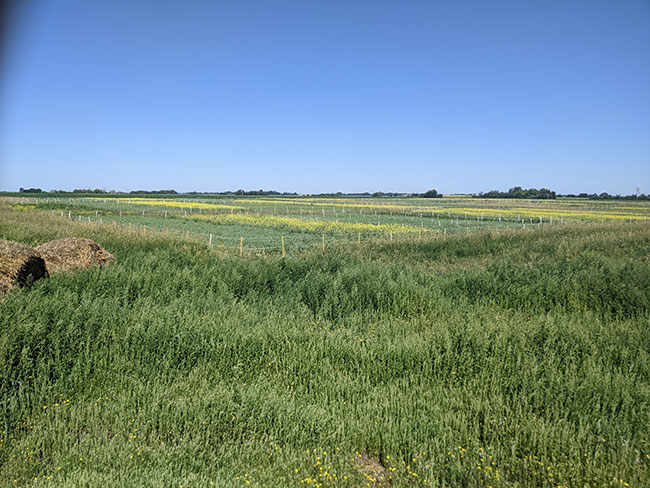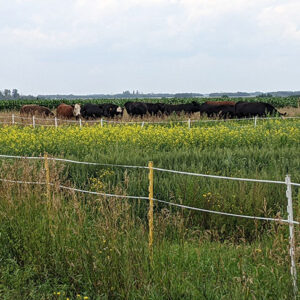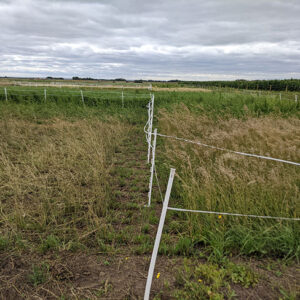
Features
Soil
Reintegrating livestock into cropping systems
Integrated systems may improve soil health and cropping system profitability.
March 20, 2024 By Donna Fleury
 The long term experiment and rotations set up with the electrical fences before grazing was implemented.
ALL Photos courtesy of Maryse Bourgault, University of saskatchewan.
The long term experiment and rotations set up with the electrical fences before grazing was implemented.
ALL Photos courtesy of Maryse Bourgault, University of saskatchewan. Managing cropping systems to improve productivity and system resilience relies on enhancing soil health. Soil organic matter is an integral part of the concept of soil health and has numerous benefits, including soil moisture retention, improved nutrient cycling and enhanced crop productivity. Researchers are exploring how reintegrating livestock into cropping systems may be a strategy for improving soil health and cropping system profitability over time.
“With the interest in improving soil health and utilizing agricultural soils for carbon sequestration, we wanted to explore whether reintegrating livestock into cropping systems could be one of the strategies. We established a new project in 2021 to develop the framework for the long-term experiment and rotations,” explains Maryse Bourgault, assistant professor and Western Grains Research Foundation (WGRF) integrated agronomy research chair at the University of Saskatchewan. “There is little research attempting a direct comparison of cropping systems and livestock integration, and this project addresses this major knowledge gap. This project takes a grain crop-centered approach, where livestock and annual or perennial forages are integrated at varying degrees to provide increasing levels of services to the grain cropping system. Initially, the project was funded through my larger WGRF research program, and more recently, we have received ADF [Agriculture Development Fun] funding that is helping us expand the project and capacity for measuring soil health and cropping system profitability.”
The project is being conducted at the USask Livestock and Forage Centre of Excellence facility at Clavet and includes several different cropping systems, including annual grain crops, annual forages and perennial forages. The overall objective of the project is to determine the degree of forage and/or livestock integration needed to improve soil health and cropping system productivity and profitability over time. The cropping systems include a diversified grain-oilseed-pulse four-year annual cropping rotation, such as cereals, peas and canola. Annual forages are included once or twice in a four-year crop rotation, and depending on the rotation, are usually a mixture of three or four species, including a mixture of cereals or a cereal-pea mix, such as triticale with oats, barley and peas, or a mixture of forage brassicas and cereals. The project also has perennial forage phases, including a three-year phase with a mixture of four or five species of legumes and grasses, and a six-year phase that includes alfalfa added to the mixture.
“We use extensive electric fencing to allow us to either include cattle grazing on the annual and perennial forage plots or to exclude them to help determine whether there are any differences of having cattle or not on the plots,” says Bourgault. “The plots are medium sized at 24 x 100 feet, so fairly large compared to typical smaller breeder plots but still small compared to commercial fields. Generally, we plan to have the cattle grazing the plots for a week to 10 days, depending on the year and the amount of forage available. Although we intended to also include fall grazing of annual crop residues, the cropping conditions so far haven’t made that possible. We are only taking observational data of cattle feeding, and so far, noted they do really like the annual forages; in particular, the cereal-pea plots are always eaten right down. Contrary to what some research shows, these cattle are avoiding any kochia that appears in the plots and definitely prefer the forage crops.”
Bourgault notes the objective of including the livestock in the experiments is to determine how much of a contribution livestock make to soil health by being part of this system versus just having a perennial plant system. She expects there will be benefits to soil health by having cattle as part of the system since the way cows transform plant material into manure and the manure decomposition is different than just straight plant residues. However, how long it will take to see results or how much livestock integration is needed are questions that still need to be answered over the long term.
“At the beginning of the project, we collected baseline samples for various soil health indicators that will help determine improvements in soil health and cropping system productivity over time,” says Bourgault. “In 2024, we will be going into year four of the rotation, and it will be the first year of terminating the three-year perennial forage, so it will be interesting to see the results. The rotation will return to an annual grain cereal crop. One of our researchers, Bobbi Helgason, has started some analysis of the microbial populations on the annual and perennial forages, comparing the grazed plots with the exclusion plots. It is going to be interesting to see if the results show any differences in the microbial populations and if they can tell us whether the cattle have been on the plots or not.”
“We expect to start to see some early results by year five or six of the rotation,” adds Bourgault. “The ADF funding includes the addition of a graduate student specifically focused on this project. This will allow us to continue with more in-depth soil health and productivity analysis and evaluation. Hopefully, this information will help us understand whether perennials and livestock are necessary to build soil health or if similar benefits could be achieved without livestock grazing. If the benefits are coming from livestock grazing, could they be achieved with annual forages included once or twice in a four-year crop rotation, and how may that differ from a three-year or longer perennial rotation? We expect the results of this long-term project to help understand strategies for improving soil organic matter and soil health, particularly in dry years. These strategies can help Prairie crop producers improve yields and profitability and improve the overall resiliency of the cropping system.”

